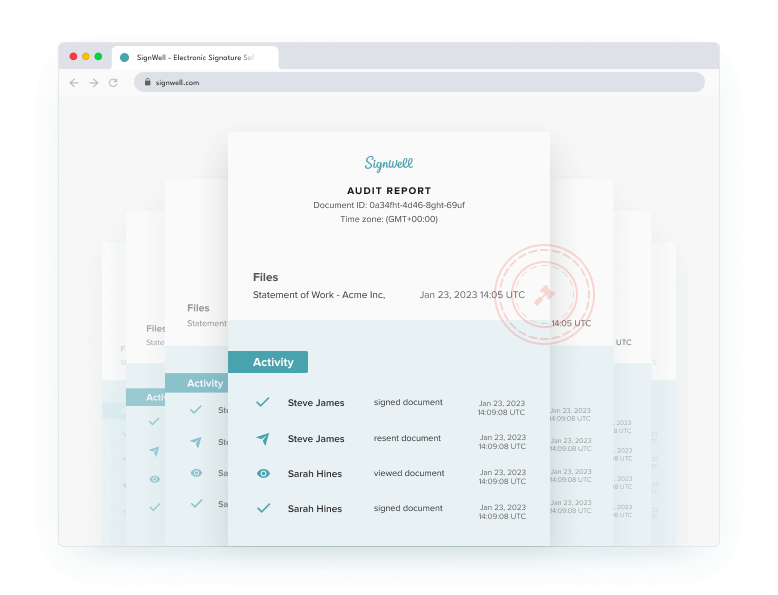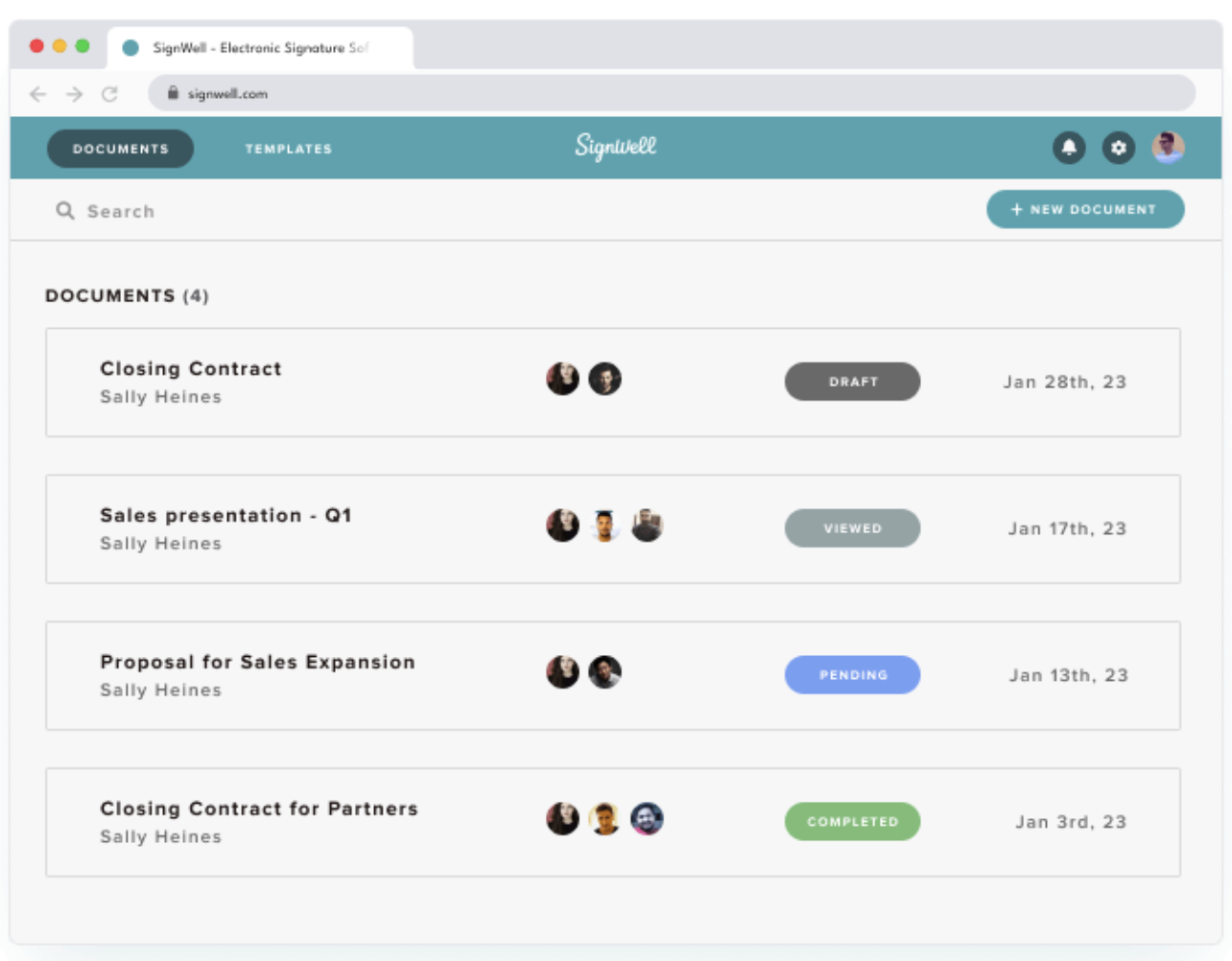Helpful Summary
- Overview: This article examines the top eSignature trends shaping the future of digital transactions, focusing on key advancements and industry shifts.
- Why You Can Trust Us: At SignWell, we stay ahead of the latest eSignature trends, helping businesses simplify their document signing processes. Our innovative solutions empower clients to leverage these trends, resulting in increased efficiency and enhanced security.
- Why This Is Important: Staying informed about eSignature trends is crucial for businesses looking to optimize their digital transactions.
- Action Points: To stay ahead, businesses should adopt eSignature solutions that integrate emerging technologies, prioritize mobile accessibility, and ensure compliance with evolving regulations.
- Further Research: Visit the SignWell blog for additional insights on the latest eSignature trends and strategies to improve your digital transaction processes.
Curious About the Latest Trends in the eSignature Space?
eSignatures are at the forefront of digital transformation, revolutionizing how businesses handle contracts, agreements, and workflows.
What this means is, as industries increasingly adopt eSignature solutions, we can anticipate significant advancements in various aspects of digital transactions.
This SignWell article takes a closer look at top eSignature trends that will shape the future of digital transactions.
But first…
Why Listen to Us?
At SignWell, we are at the forefront of the latest eSignature trends, having successfully assisted numerous businesses in transforming and simplifying their document signing processes. Our innovative eSignature solutions empower clients to harness these trends, leading to significantly increased efficiency and enhanced security in their workflows.

7 Top eSignature Trends We’ve Noticed in 2024
1. Advanced Artificial Intelligence Integration
Artificial Intelligence (AI) continues to be a powerful catalyst for innovation, particularly when it comes to eSignatures. Currently, AI enhances the signing process in multiple ways:
- Automation of Repetitive Tasks: AI automates tasks such as sending reminders for pending signatures, significantly expediting workflow efficiency.
- Analysis of Signing Patterns: By leveraging machine learning algorithms, AI can analyze past signing behaviors to predict and optimize future interactions. This capability enhances security, making it increasingly difficult for unauthorized individuals to impersonate others. It distinguishes between genuine signatures and forgeries by examining unique characteristics, including stroke patterns, pressure points, and timing of the signing action.
- Fraud Detection: In addition to analyzing signing patterns, AI actively monitors for unusual or suspicious behaviors during the signing process. By identifying discrepancies in document interactions, it can flag potential fraud attempts, thereby providing an added layer of security.
- Identity Verification: Looking ahead, we anticipate greater integration of AI in verifying the identity of signers. For instance, AI can assess biometric data or analyze user interactions with documents to ensure that the correct individual is signing.
This not only enhances the safety of the signing process but also quickens it. As this technology evolves, we can expect even more secure and advanced electronic signatures.
2. Increased Mobile Usage for eSignatures
The global number of smartphone users is projected to reach nearly 6.2 billion by 2029. As mobile device usage continues to rise, an increasing number of individuals will be signing documents on their smartphones and tablets.
Consequently, eSignature solutions must be fully optimized for mobile use to provide a seamless user experience across all devices.
At SignWell, we’re prepared for this shift. Our browser-based eSignature tool works great on mobile devices allowing users to easily create, send, and sign documents on the go. See our guide on how to sign a PDF document on your phone.
Key Drivers of Mobile eSignature Adoption:
- Built-In eSignature Software: The emergence of devices with integrated eSignature capabilities is set to revolutionize the signing process. Users will no longer need to download separate apps, enhancing convenience and accessibility.
As manufacturers increasingly embed eSignature functionalities directly into their devices, signing transactions will become even simpler.
- Enhanced Mobile Security: Improvements in mobile device security are also fueling the adoption of eSignatures. With advancements that protect sensitive information and reduce the risk of fraud, both businesses and individuals are more inclined to embrace electronic signatures.
As trust in mobile security continues to grow, we can anticipate wider adoption of eSignature solutions across various industries.
3. Improved Security Features
Concerns about the security of electronic signatures have led some businesses to hesitate in their adoption. However, advancements in security technology are effectively addressing these concerns, making eSignatures more secure than ever.
Modern eSignature platforms now offer a variety of robust security features, including:
- Multi-Factor Authentication (MFA): This additional layer of security requires users to provide two or more verification factors to gain access, ensuring that only authorized individuals can sign documents.
- End-to-End Encryption: This technology protects your data during transmission and storage, keeping it confidential and secure.
- Detailed Audit Trails: Comprehensive logs of all actions taken on your documents provide complete visibility and accountability, helping you maintain compliance with regulatory standards.

At SignWell, we prioritize your security. Our advanced encryption protocols safeguard your documents throughout the signing process, allowing you to manage digital transactions confidently, knowing that your sensitive information is well protected.
Emerging Security Measures
- Biometric Authentication: This innovative method verifies signers‘ identities using unique physical traits, such as fingerprints or facial recognition. By adding this extra layer of protection, we can significantly reduce the risk of unauthorized access.
- Digital Certificate-Based Authentication: This approach utilizes cryptographic certificates to verify the identities of signers, ensuring that signatures are genuine and that the signer is who they claim to be. By linking each signature to a unique digital certificate, this method enhances security and provides a reliable way to validate electronic transactions.
As more businesses adopt these advanced technologies, the trust and integrity of eSignature processes will continue to strengthen. Hence, we can anticipate even more innovative solutions that enhance the security of electronic signatures, making them a trustworthy option for both businesses and individuals.
4. Emergence of Blockchain Technology in Electronic Signatures
As the buzz around blockchain technology continues to grow, businesses can leverage it to enhance the security and efficiency of their electronic signature processes.
- Direct Verification and Security: Unlike traditional eSignatures that often rely on third-party authentication, blockchain enables direct verification between parties. Once a document is signed, the transaction is recorded on the blockchain, making it nearly impossible to alter or forge.
This results in a more secure and transparent signing process, instilling greater confidence in the integrity of agreements.
- Increased Efficiency: all signatures and transactions are recorded on a public ledger, which enhances transparency and simplifies tracking and auditing for businesses. Blockchain technology significantly improves the efficiency of electronic signatures by:
- Eliminating Intermediaries: The need for third-party verification is reduced, streamlining the signing process.
- Optimizing Transactions: Parties can sign documents instantly, minimizing delays associated with traditional verification methods and enhancing workflows.
- Smart Contracts: Another exciting development in this space is the emergence of smart contracts. These automated agreements execute actions when predefined conditions are met, eliminating the need for manual oversight. Once all parties sign a document, the terms can be enforced automatically, smoothing out processes and reducing the chances of disputes.
As more businesses adopt blockchain technology, we can anticipate even greater efficiency and trust in electronic transactions, positioning blockchain as a cornerstone of future digital signing practices.
5. Increased Regulatory Measures and Compliance
Electronic signatures are already governed by various laws designed to ensure their legality and security. Key regulations include:
- United States: The Electronic Signatures in Global and National Commerce (ESIGN) Act.
- European Union: The Electronic Identification, Authentication, and Trust Services (eIDAS) Regulation.
- Canada: The Personal Information Protection and Electronic Documents Act (PIPEDA).

These laws establish that electronic signatures are legally binding across different regions, granting them the same legal status as traditional handwritten signatures. Additionally, they set security standards to protect the integrity of documents and transactions, preventing tampering or forgery.
Future Regulatory Trends
As the popularity of eSignatures continues to rise, we can anticipate even tighter regulations and standards. Governments and regulatory bodies are likely to update existing laws or introduce new ones to address emerging security concerns, ensuring that digital transactions remain compliant and trustworthy across various industries.
For instance, we may see:
- Stricter Data Protection Regulations: New rules governing the safeguarding of personal data during eSignature processes.
- Standards for Biometric Authentication: Regulations establishing guidelines for using biometric methods, such as fingerprint scans, in electronic signatures.
These regulatory changes will enhance confidence in electronic signatures, encouraging more organizations to adopt them. Also, as organizations and individuals become more aware of the security and legality of eSignatures, compliance with these laws will naturally increase.
6. Growing Need for Digital Agreement Collaborations
Currently, eSignatures are primarily utilized at the end of the agreement process. Parties often rely on traditional methods to create and negotiate agreements before using eSignatures to finalize them. While this marks a significant improvement over paper-based processes, it overlooks the broader potential that eSignatures can offer.

The Evolution of eSignatures
In the future, eSignatures will transcend their role as mere endpoints in agreements. Instead, they will become integral to the entire agreement process, enabling a seamless and collaborative digital workflow. This transformation will allow for:
- Real-Time Collaboration: Stakeholders will engage in virtual negotiations via video or chat, facilitating immediate interactions and adjustments.
- Dynamic Document Management: Parties will be able to make changes and track revisions within a unified digital environment, streamlining the entire agreement lifecycle.
As businesses continue to embrace digital transformation, we can expect eSignatures to be integrated earlier in the workflow. This shift will foster a more efficient, transparent, and simplified experience from start to finish. By enhancing collaboration and productivity, the integration of eSignatures will pave the way for more sophisticated digital solutions that meet the evolving demands of modern businesses.
7. The Growth of Internal Digitization
Organizations increasingly recognize that traditional processes can no longer meet the demands of modern business. Consequently, they are steadily digitizing their operations, leading to a paradigm shift where eSignatures are no longer an afterthought but an integral part of daily workflows.
The Role of eSignatures in Digitization
eSignatures are becoming essential for expediting approvals, contracts, and documentation within teams. As companies rely more on electronic signatures, they are incorporating them into their existing digital platforms, resulting in signing processes that are faster and more secure.
- Streamlined Operations: We anticipate scenarios where contracts, approvals, and documents are managed entirely online, with eSignatures facilitating swift and efficient decision-making.
- Environmental Benefits: This internal digitization reduces reliance on paper, contributing to more environmentally friendly operations.
Enhanced Collaboration and Integration
As more departments adopt electronic signature solutions, we can expect greater integration across various digital platforms. This interconnectedness enhances collaboration and transparency, enabling teams to work together in real time, regardless of their physical location.
The outcome? A more agile organization capable of adapting to changing market conditions and evolving customer needs.
Stay Ahead of eSignature Trends with SignWell
eSignatures are already changing how we carry out transactions and hold even more promise in the future. To maximize the benefits of digital signing, it’s crucial to stay updated on the latest trends. But that’s not enough; you also need to select an eSignature platform that evolves with the times.
At SignWell, we are committed to adapting to the ever-evolving digital transaction environment. With an optimized document workflow, intuitive interface, seamless integrations, and comprehensive audit reports, we provide everything you need for efficient electronic transactions.
Sign with a team that knows what you need.
Putting a signature on a document shouldn’t be hard. The SignWell mission? Simplify how documents get signed for millions of people and businesses.
Get Started Todaybusinesses served, so far...
total documents signed
customer support satisfaction